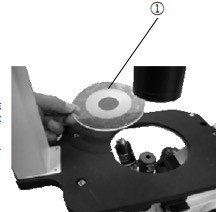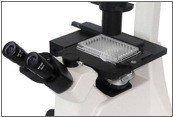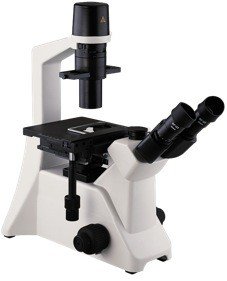Inverted Microscopes
If you are dealing with tissue culture, cell culture, handling liquids in your device, or flipping over the sample is not possible, then an inverted microscope is the right solution for you. One likes to make a video of living cells to know how the cells grow, divide or die and figure out their dynamics rate, you will need an inverted biological microscope, plus a digital camera and software for the time-lapse imaging mode.
For industrial application, such as dealing with all metals, semiconductors, it is not really big advantage of using a metallurgical inverted microscope over an upright. The only benefit would be just a personal preference or longer life-time of the device. Over the decades of using a microscope, academics prefer an inverted over upright as they have found it is much durable and has less chance of breaking if a student can make mistake on using it. We leave this to your own preference and judgment.
1. What to consider in selecting an inverted microscope before buying?
1.1. Objective lenses-magnification:
Normally the inverted microscopes come with 10x, 20x and 40x obj lenses, some models include 4x. A 4x obj lens allows seeing an entire field of a well in a 96-well plate. Using over 50x magnification is less common in inverted microscopy application. Although several You can get obj lenses from 1.25x till 150x and even more. When you use 60x or 100x objective lens with an inverted microscope, make sure the obj lens does not hit the stage when you rotating the nosepiece.
1.2.Objective lenses-Working distance:
Working distance (WD) of an objective lens is defined as a distance from the edge of the lens until the specimen. If you use a 100x/NA 1.25/WD: 0.12mm to see tissue culture cells inside a well of a 96-well plate, you will see nothing! Why? Because the thickness of well plate plastic is around 0.5mm which is longer than lens WD=0.12mm. Inverted tissue culture microscopes use objective lenses that have working distance bigger than the thickness of a cell culture plate, such as well-plate, petri-dish, T-flask, glass slide chamber etc.
2. Imaging Modes:
Using brightfield, phase-contrast, fluorescence / epi-fluorescence, and darkfield imaging are common imaging modes. Some researchers like to use Hoffman module contrast over phase-contrast, and also like using DIC Nomarski.
2.1.Phase Contrast:
generally speaking 10x, 20x and 40x obj lenses with Phase Contrast are available. Depending on the model you can expect a 4x Ph as well and might be a 100x Phase contrast (which is normally custom).
There are are few models of phase contrast objective lenses which are designed for fluorescence application as well.
3. Illumination
3.1. Halogen or LED?
Upgrade: Think of long future use of the microscope. Can you upgrade it to have more features? Having fluorescence imaging capability, switching to LED, more spots for extra obj lenses, might be having polarized, darkfield, and probably DIC Nomarski and so are examples of the questions we ask our clients before suggesting a model.
Bioimager’s Inverted Biological Microscopes are offered in two main groups:
1. Portable Microscopes: Compact Design, fits inside hood and incubator, such as IncuScope, BMI200, UniVis-100, UNIVIS-500.
2. Lab Microscopes such as BIM500
we have recently developed a polarization kit for inverted biological microscope such as BIM500P which can be customized for other models.



